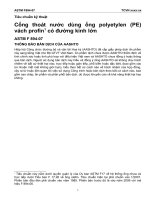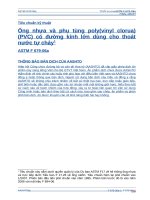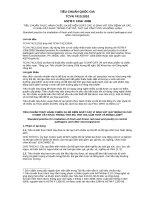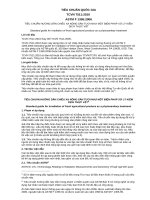Astm f 1580 12
Bạn đang xem bản rút gọn của tài liệu. Xem và tải ngay bản đầy đủ của tài liệu tại đây (84.51 KB, 4 trang )
Designation: F1580 − 12
Standard Specification for
Titanium and Titanium-6 Aluminum-4 Vanadium Alloy
Powders for Coatings of Surgical Implants1
This standard is issued under the fixed designation F1580; the number immediately following the designation indicates the year of
original adoption or, in the case of revision, the year of last revision. A number in parentheses indicates the year of last reapproval. A
superscript epsilon (´) indicates an editorial change since the last revision or reapproval.
rials for Surgical Implants with Respect to Effect of
Materials on Muscle and Bone
F1472 Specification for Wrought Titanium-6Aluminum4Vanadium Alloy for Surgical Implant Applications (UNS
R56400)
2.2 ISO Standards:3
ISO 9001 Quality Management System Requirements
2.3 Aerospace Material Specifications:4
AMS 2249 Chemical Check Analysis Limits, Titanium and
Titanium Alloys
AMS 4998 Powder, 6Al-4V
1. Scope*
1.1 This specification covers the requirements for unalloyed
titanium and Ti-6Al-4V alloy powders for use in fabricating
coatings on titanium alloy implants.
1.2 Powders covered under this specification may be used to
form coatings by sintering or thermal spraying techniques.
1.3 This specification covers powder requirements only. It
does not address properties of the coatings formed from them.
1.4 Finely divided titanium powder may be considered
pyrophoric and should be handled in accordance with the
appropriate guidelines.
3. Significance and Use
1.5 The values stated in inch-pound units are to be regarded
as standard. The values given in parentheses are mathematical
conversions to SI units that are provided for information only
and are not considered standard.
3.1 Coatings formed from metallic powders have become
widely used as a means of improving tissue attachment to
implants. Such coatings have also been demonstrated to
improve bonding of acrylic cement to prostheses. This
specification addresses the special requirements of the metal
powders used to form these coatings.
2. Referenced Documents
2.1 ASTM Standards:2
B214 Test Method for Sieve Analysis of Metal Powders
B215 Practices for Sampling Metal Powders
B299 Specification for Titanium Sponge
E11 Specification for Woven Wire Test Sieve Cloth and Test
Sieves
E29 Practice for Using Significant Digits in Test Data to
Determine Conformance with Specifications
E2371 Test Method for Analysis of Titanium and Titanium
Alloys by Atomic Emission Plasma Spectrometry
F67 Specification for Unalloyed Titanium, for Surgical Implant Applications (UNS R50250, UNS R50400, UNS
R50550, UNS R50700)
F981 Practice for Assessment of Compatibility of Biomate-
4. Methods of Manufacture
4.1 Powders may be manufactured by the plasma rotating
electrode process, inert gas atomization, hydride-dehydride, or
other method capable of producing powder meeting the requirements of this specification.
5. Chemical Requirements
5.1 The chemical analysis of the powder shall conform to
the requirements specified in Table 1.
5.1.1 Requirements for the major and minor elemental
constituents for unalloyed titanium and Ti-6Al-4V alloy powders are listed in Table 1. Also listed are all important residual
elements. Analysis for elements not listed in Table 1 is not
required to verify compliance with this specification.
5.2 The product analysis tolerance shall conform to the
requirements set forth in Table 2.
1
This specification is under the jurisdiction of ASTM Committee F04 on
Medical and Surgical Materials and Devices and is under the direct responsibility of
Subcommittee F04.12 on Metallurgical Materials.
Current edition approved March 1, 2012. Published March 2012. Originally
approved in 1995. Last previous edition approved in 2007 as F1580 - 07. DOI:
10.1520/F1580-12.
2
For referenced ASTM standards, visit the ASTM website, www.astm.org, or
contact ASTM Customer Service at For Annual Book of ASTM
Standards volume information, refer to the standard’s Document Summary page on
the ASTM website.
5.3 For referee purposes, Test Method E2371 shall be used.
3
Available from American National Standards Institute (ANSI), 25 W. 43rd St.,
4th Floor, New York, NY 10036, .
4
Available from Society of Automotive Engineers (SAE), 400 Commonwealth
Dr., Warrendale, PA 15096-0001, .
*A Summary of Changes section appears at the end of this standard
Copyright © ASTM International, 100 Barr Harbor Drive, PO Box C700, West Conshohocken, PA 19428-2959. United States
1
F1580 − 12
TABLE 1 Chemical Requirements
Element
Unalloyed
Ti PowderA
% (mass/mass)
Min
Al
V
O
Fe
C
H
N
Cu
Sn
Si
Cl
Na
Y
Ti
Max
0.40
0.50
0.08
0.05
0.05
Ti Sponge
PowderB
% (mass/mass)
Min
6. Particle Size
Ti-6Al-4V
PowderC
% (mass/mass)
Max
Min
Max
0.05
5.50
3.50
6.75
4.50
0.20
0.30
0.08
0.015
0.05
0.10
0.10
0.40D
0.15
0.03
0.03
0.02
6.1 Powder shall be sieved to the customer’s requirements
with stainless steel screens conforming to Specification E11.
Analysis of sieved powder for conformance to the customer’s
particle size range requirements shall be in accordance with
Test Method B214.
7. Cleanliness
7.1 Powder shall be handled at all times so as to ensure
freedom from contamination with nonmetallic materials or
other metal alloy powders or both.
0.04
0.20E
7.2 Powder cleanliness shall be determined by examining a
representative sample, per Practices B215 or as agreed upon
between buyer and seller, comprising at least 1 in.2 (6.45 cm2)
of a closely packed mono-layer of powder per lot at 20×
magnification. No foreign material shall be visible under these
conditions.
F
balanceG
0.005C
balanceG
balanceG
A
Chemistry per Specification F67 except hydrogen.
Chemistry per Specification B299, general purpose grade.
C
Chemistry per Specification F1472.
D
Oxygen per Specification B299 is 0.15 %. This level is reasonable for sponge
product but not for powder because of the increased surface area of small particle
powder product.
E
Lower maximum chlorine content may be agreed upon between buyer purchaser
and seller supplier.
F
Sodium or magnesium, 0.50 maximum.
G
The percentage of titanium is determined by difference and need not be
measured.
B
8. Significance of Numerical Limits
8.1 The following applies to all specified numerical limits in
this specification. To determine conformance to these limits, an
observed or calculated value shall be rounded to the nearest
unit in the last right hand digit used in expressing the
specification limit, in accordance with the rounding method of
Practice E29.
TABLE 2 Product Analysis TolerancesA
Element
Aluminum
Vanadium
Oxygen
Oxygen
Hydrogen
Iron
Carbon
Nitrogen
Copper
Tin
Silicon
Yttrium
Element Variation Under Min or Over
Max
9. Certification
9.1 Powder shipped under this specification shall be accompanied by certification that includes:
9.1.1 ASTM designation and date of issue.
9.1.2 Quantity (weight).
9.1.3 Method of manufacture.
9.1.4 Chemical analysis per 5.1.
9.1.5 Sieve analysis per 6.1.
9.1.6 Powder cleanliness per 7.2.
9.1.7 Other requirements.
0.04
0.015
0.03B
0.02C
0.002
0.10
0.02
0.02
0.05
0.15
0.02
0.0005C
A
Refer to AMS 2249.
For unalloyed Ti powder.
C
For Ti-6Al-4V alloy powder.
10. Quality Program Requirements
5.4 Intentional elemental additions other than those specified in Table 1 are not permitted.
11. Keywords
B
10.1 The supplier shall maintain a quality program, such as
that defined in ISO 9001 or similar quality program.
11.1 coatings; metallic; metals (for surgical implants titanium alloys); orthopaedic medical devices (titanium/titanium
alloys); powder; porous coatings; titanium/titanium alloys (for
surgical implants)
5.5 For powder that includes particle size fractions finer
than 200 mesh (74 µm), the oxygen content limits shall be
agreed upon between buyer and seller.
2
F1580 − 12
APPENDIXES
(Nonmandatory Information)
X1. RATIONALE
X1.1 Coatings formed from metallic powders have become
widely used as a means of improving tissue attachment to
uncemented orthopedic joint prosthesis. Such coatings have
also been demonstrated to improve bonding of acrylic cement
to prostheses.
and corrosion behavior must be characterized on finished
coatings.
X1.8 Likewise, these heat treatments can create microstructures that give substantially different corrosion fatigue behavior
from that of typical wrought titanium alloys. Corrosion fatigue
behavior must be evaluated on finished coated substrates.
X1.2 The biocompatibility of metallic implants is a direct
function of their composition. The compositions of titanium
and titanium alloy powders allowed by this specification have
been used in wrought form for surgical implants and are in
widespread commercial use for fabrication of porous coatings.
X1.9 Pore size and morphology are important factors influencing tissue ingrowth and acrylic penetration of porous
coatings. Particle size, size distribution, and shape are critical
to controlling the pore size and morphology in the final
coating. Particle size and size distribution are conventionally
controlled by screening. The referenced ASTM International
standards allow comparison of powder to a manufacturer’s
specifications for a given coating process. A number of
methods to characterize particle shape exists. The coating
manufacturer should select a means of particle shape characterization suitable for this process.
X1.3 Chemical composition limits for oxygen, iron, carbon,
and nitrogen in the unalloyed grade are taken from Specification F67, Grade 4. Limits for silicon, chlorine, hydrogen, and
sodium are taken from Specification B299, Grade SL.
X1.4 Chemical composition limits for aluminum,
vanadium, oxygen, iron, carbon, hydrogen, and nitrogen in the
Ti-6Al-4V grade are taken from Specification F1472. Limits
for copper and tin are taken from AMS 4998.
X1.10 This specification requires sampling for particle size
and powder cleanliness on each powder lot. In some cases,
sampling on each shipping container of powder may be
appropriate.
X1.5 Product analysis tolerances are taken directly from
AMS 2249. No recognized product analysis tolerances currently exist specifically for chlorine or sodium in titanium
alloys.
X1.11 Other process parameters are also critical to determining final pore size and morphology in the final coating.
Because these parameters are not directly related to the
chemical and physical characteristics of the starting powder,
they are not addressed in this specification.
X1.6 Processing aids are frequently used to facilitate powder processing and application of porous coatings to implant
surfaces. It is beyond the scope of this specification to identify
suitable processing aids or define their use. It is the responsibility of the implant manufacturer to ensure that any processing
aid or residue of a processing aid has no detrimental effect on
biocompatibility or coating properties.
X1.12 The requirements for powder cleanliness ensure freedom from contaminants that might adversely affect either the
biocompatibility or the finished coatings or the ability to bond
the coating properly during manufacturing. The method in 7.2
(Practices B215) is commonly used for relatively coarse
spherical powders used to fabricate sintered porous coatings.
Other types of powders may require different methods for
cleanliness characterization. The development and implementation of such methods are the responsibility of the implant
manufacturer.
X1.7 It should be recognized that the heat treatments used to
form porous coatings can create microstructures that are
substantially different from wrought titanium alloys. Porous
coated implants also exhibit much greater surface area than
monolithic implants. For these reasons, the biocompatibility
3
F1580 − 12
X2. BIOCOMPATIBILITY
X2.1 The alloy composition covered by this specification
has a long history of successful clinical application in soft
tissue and bone implants in humans, with a well-characterized
level of biological response.
human body. Long-term clinical experience of the use of the
material referred to in this specification, however, has shown
that an acceptable level of biological response can be expected,
if the material is used in appropriate applications.
X2.2 No known surgical implant material has ever been
shown to be completely free from adverse reactions in the
SUMMARY OF CHANGES
Committee F04 has identified the location of selected changes to this standard since the last issue (F1580 – 07)
that may impact the use of this standard. (Approved March 1, 2012.)
The document was revised according to the template language:
(1) Section 10, revised to eliminate reference to ASQ C1.
(2) Section 2. revised to remove ASQ C1 and corresponding
footnote.
ASTM International takes no position respecting the validity of any patent rights asserted in connection with any item mentioned
in this standard. Users of this standard are expressly advised that determination of the validity of any such patent rights, and the risk
of infringement of such rights, are entirely their own responsibility.
This standard is subject to revision at any time by the responsible technical committee and must be reviewed every five years and
if not revised, either reapproved or withdrawn. Your comments are invited either for revision of this standard or for additional standards
and should be addressed to ASTM International Headquarters. Your comments will receive careful consideration at a meeting of the
responsible technical committee, which you may attend. If you feel that your comments have not received a fair hearing you should
make your views known to the ASTM Committee on Standards, at the address shown below.
This standard is copyrighted by ASTM International, 100 Barr Harbor Drive, PO Box C700, West Conshohocken, PA 19428-2959,
United States. Individual reprints (single or multiple copies) of this standard may be obtained by contacting ASTM at the above
address or at 610-832-9585 (phone), 610-832-9555 (fax), or (e-mail); or through the ASTM website
(www.astm.org). Permission rights to photocopy the standard may also be secured from the ASTM website (www.astm.org/
COPYRIGHT/).
4









